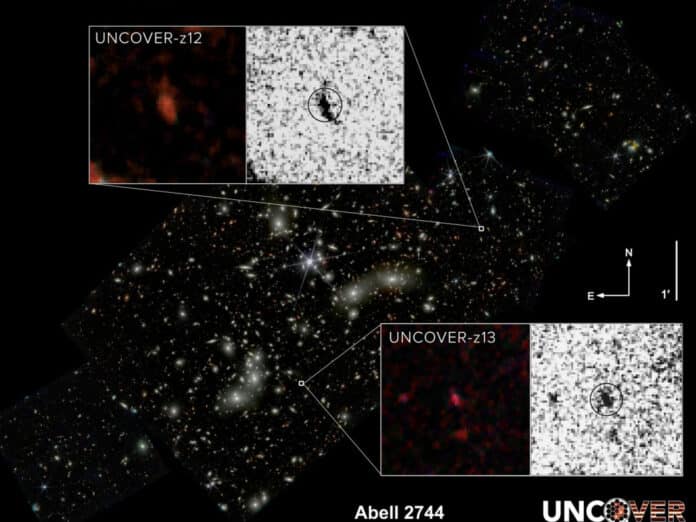NASA’s James Webb Space Telescope (JWST) discovered the second and fourth-most distant galaxies (UNCOVER z-13 and UNCOVER z-12) ever observed. It is located in a region of space known as Pandora’s Cluster, or Abell 2744.
The reports show these galaxies are larger than others at such extreme distances. One is at least six times larger at about 2,000 light-years across. For comparison, the Milky Way is approximately 100,000 light-years across. However, the early universe is thought to have been very compressed, so surprisingly, the galaxy is as large as it is.
These galaxies are located at a distance of nearly 33 billion light years away. The discovery of these galaxies offers insights into how the earliest galaxies might have formed.
Using new spectroscopic data—information about light emitted across the electromagnetic spectrum—from JWST, an international team led by Penn State researchers validated the distance of these ancient galaxies and deduced their features based on a deep field image of the region.
The new galaxies are larger and resemble a peanut and a fluffy ball in images, in contrast to existing galaxies confirmed at this distance that show up as red dots.
First author Bingjie Wang, a postdoctoral scholar in the Penn State Eberly College of Science and a member of the JWST UNCOVER said, “Very little is known about the early universe, and the only way to learn about that time and to test our theories of early galaxy formation and growth is with these very distant galaxies. Before our analysis, we knew only three galaxies confirmed around this extreme distance. Studying these new galaxies and their properties has revealed the diversity of galaxies in the early universe and how much there is to be learned from them.”
These galaxies’ light offers a peek into the past because they had to travel such an enormous distance to reach Earth. The two galaxies emitted the light, which the research team thinks traveled 13.4 billion light years to get the JWST, from when the universe was approximately 330 million years old. However, because of the universe’s expansion over this time, the researchers claimed, the galaxies are today closer to 33 billion light years away from Earth.
These galaxies are approximately three times older than the Earth, based on the age of their light. With light bursting through the extremely thin hydrogen gas that comprised the early universe, these early galaxies resemble beacons. Thanks to their brightness, we can only glimpse the mysterious physics governing the galaxy close to the cosmic start.
The two galaxies were among 60,000 sources of light in Pandora’s Cluster. The team also used other models to infer the properties of these early galaxies. The two galaxies were young, had few metals, expanded quickly, and actively generated stars, just as the astronomers had predicted.
Journal Reference:
- Bingjie Wang, Seiji Fujimoto et al. UNCOVER: Illuminating the Early Universe—JWST/NIRSpec Confirmation of z > 12 Galaxies. The Astrophysical Journal Letters. DOI 10.3847/2041-8213/acfe07
